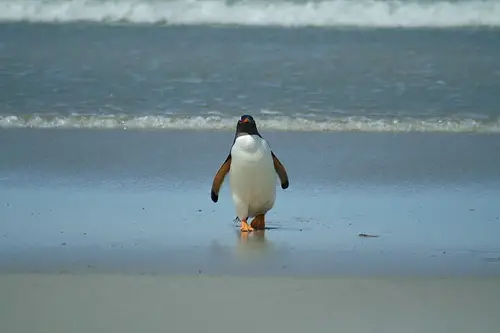Although a Penguin's wings appear to be more like flippers, they are wings that have evolved along with the bird to help it to "fly" through water.
As water is a denser medium than air, their wings are small and sturdy. However, this adaptation has cost it the ability to fly in the air. Penguins may look ungainly on land, but once in the water they are transformed into truly graceful birds that glide along effortlessly. They use their wings in the same way and with the same action as other air-borne birds. They use their tails and webbed feet to steer and brake. Their average cruising speed is 7 km/hr though they can reach up to 14km per hour in a short burst.
Unfortunately, the evolutionary history of penguins has not progressed much because penguin fossils are rare. The few fossils that were found prove that prehistoric penguins were much like the modern penguin and were flightless and seagoing. In all probability, their origins may date as far back as 65 million years ago.
As water is a denser medium than air, their wings are small and sturdy. However, this adaptation has cost it the ability to fly in the air. Penguins may look ungainly on land, but once in the water they are transformed into truly graceful birds that glide along effortlessly. They use their wings in the same way and with the same action as other air-borne birds. They use their tails and webbed feet to steer and brake. Their average cruising speed is 7 km/hr though they can reach up to 14km per hour in a short burst.
Unfortunately, the evolutionary history of penguins has not progressed much because penguin fossils are rare. The few fossils that were found prove that prehistoric penguins were much like the modern penguin and were flightless and seagoing. In all probability, their origins may date as far back as 65 million years ago.
